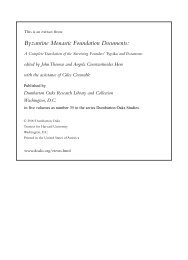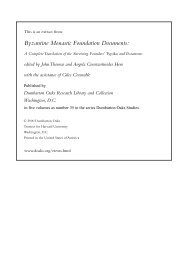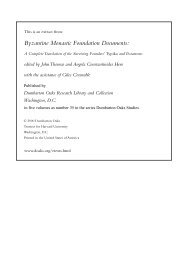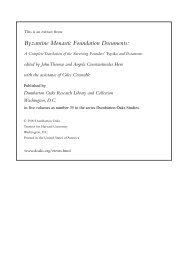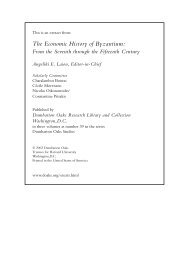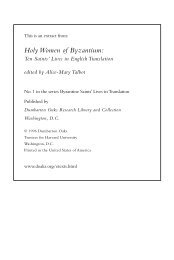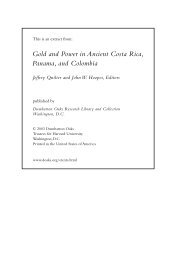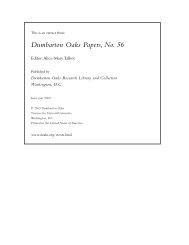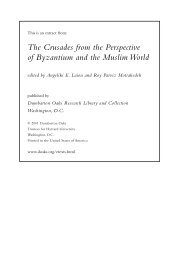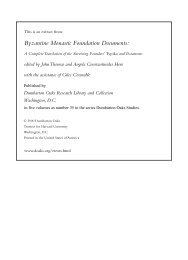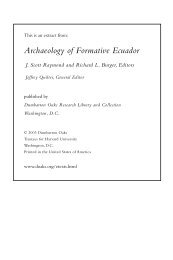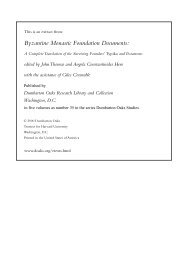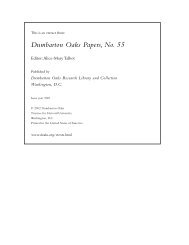Nature and Ideology: Natural Garden Design in ... - Dumbarton Oaks
Nature and Ideology: Natural Garden Design in ... - Dumbarton Oaks
Nature and Ideology: Natural Garden Design in ... - Dumbarton Oaks
Create successful ePaper yourself
Turn your PDF publications into a flip-book with our unique Google optimized e-Paper software.
“TEUTONIC” TRENDS<br />
5. Frontispiece of Willy Pastor’s book<br />
Aus germanischer Vorzeit, Berl<strong>in</strong>, 1907<br />
the German Reich <strong>in</strong> 1871, the nationalization of all spheres of life became more <strong>and</strong> more<br />
reactionary <strong>in</strong> character. Teutonic history was more <strong>and</strong> more aggressively contrasted as superior<br />
to the cultural traditions of other peoples.<br />
Thus one can recognize at the turn of the n<strong>in</strong>eteenth to the twentieth century an <strong>in</strong>creas<strong>in</strong>g<br />
search for the heritage of the German people <strong>in</strong> order to substantiate the claim of the German<br />
Reich for world power. Particular attention was paid, with regard to a Germanic heritage, to a<br />
specific relationship of the German people to nature <strong>and</strong> l<strong>and</strong>scape. One should mention, for<br />
example, the art historian Josef Strzygowski (1862–1941) <strong>and</strong> the writer Willy Pastor (1867–<br />
1933). Pastor, Strzygowski, <strong>and</strong> also the l<strong>and</strong>scape architect Willy Lange belonged to the same<br />
generation, born <strong>in</strong> the 1860s. Pastor discussed ideas about the history of the ancient Germanic<br />
tribes <strong>in</strong> numerous publications <strong>and</strong>, for example, tried to correct the image “of the often defamed<br />
‘barbaric’ early history of Germania” 16 <strong>in</strong> his one-sided book From Germanic Prehistoric<br />
Times (Aus germanischer Vorzeit) (Fig. 5), published <strong>in</strong> 1907. Pastor’s works <strong>and</strong> numerous other<br />
publications were <strong>in</strong>tended to prove the outst<strong>and</strong><strong>in</strong>gly high cultural level of the prehistoric Germanic<br />
tribes. For Pastor there was no doubt that “as well as the decisive waves of people, the<br />
decisive waves of culture came from the North.” 17 He believed <strong>in</strong>, as he called it, the “doctr<strong>in</strong>e of<br />
the Nordic orig<strong>in</strong> of any culture.” 18 Similarly, Strzygowski compla<strong>in</strong>ed that the high level of<br />
16 W. Pastor, Aus germanischer Vorzeit, Berl<strong>in</strong>, 1907, “Vorwort.”<br />
17 Ibid., 11.<br />
18 W. Pastor, Die Erde <strong>in</strong> der Zeit des Menschen: Versuch e<strong>in</strong>er naturwissenschaftlichen Kunstgeschichte, Jena <strong>and</strong> Leipzig,<br />
1904, 189.<br />
193




